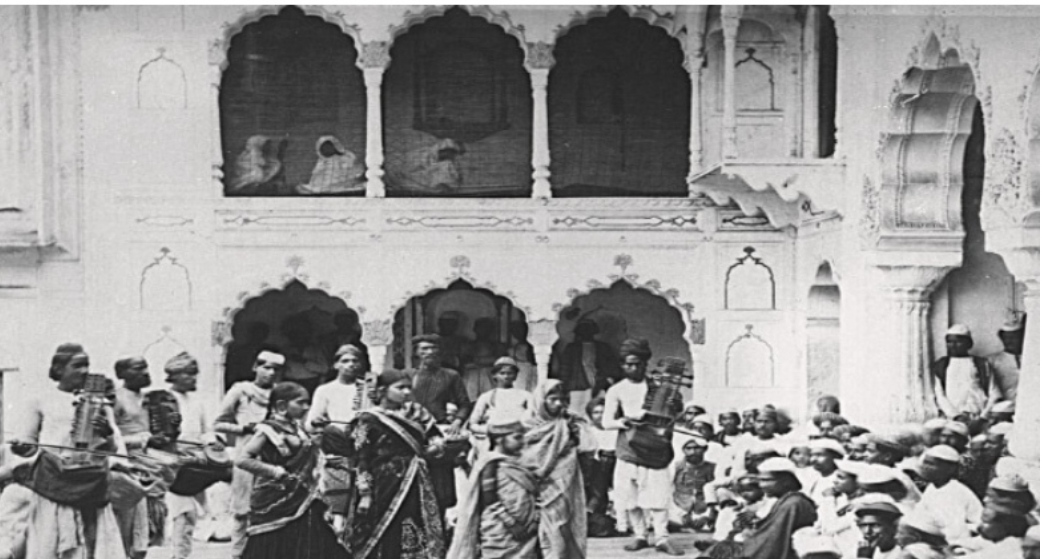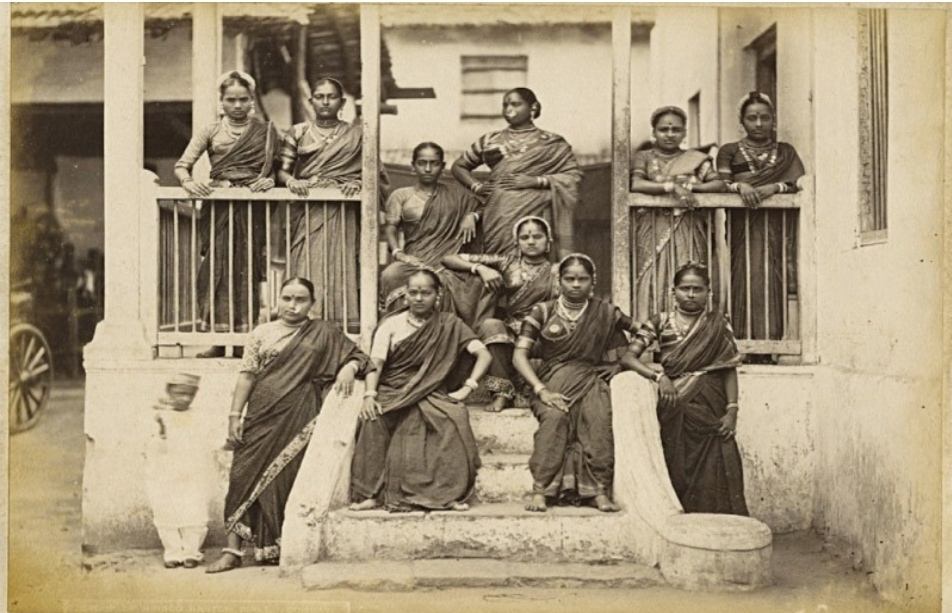History : Where did the tawaif’s go?
By Rahma Ali

‘Native Nautch’ at Delhi or Shalimar, c 1864
Pakistan’s tawaifs [courtesans] occupy shadow spaces in the country’s social fabric. It might seem natural for women belonging to this pesha [occupation] to hold the status they do, but the truth of the matter is that once upon a pre-colonial time, their position was far more elevated.
Over time — dating back to the times of the colonial intervention in India — different forces in power, including the Mughal Empire, India’s feudal lords, the British and the rising nationalists of India and Pakistan, competed for primacy in determining social attitudes towards the tawaifs. These forces have actively sought to ‘delete’ the figure of the tawaif from our imagination. This process to evict tawaifs from the acceptable realm of society — and in time, our collective memory (both oral and in writing) — was initiated in the Indian Subcontinent by the British Raj.
BEFORE AND AFTER THE BRITISH
The period between the 15th and 21st centuries in India (referred to as ‘modern India’) is perhaps the most essential time to assess the major ruptures in the Indian Subcontinent’s courtesan culture.
While the tawaifs were patronised by the Mughal royal courts or the Nawab of Lucknow, they enjoyed great esteem. They were considered powerhouses of Indian aesthetic and spiritual culture. They exercised a magnetic stronghold over the minds of the Indian royalty and nobility, commanding dignity and reverence for their professional training in aesthetics, etiquette and the performance of dance and music.
In Mughal India, Hindu wives imitated the fashion choices of the tawaifs. They fashioned their hair, clothes and jewellery in ways that were noticeably borrowed from the ways of the tawaifs. In early modern articulations of culture, social etiquette and social influence were synonymous with professional training in the musical and literary arts. And the Indian tawaif epitomised the ideal in this regard.
However, the British arrival changed the high stature of the tawaifs. While the British coloniser’s initial reaction to the courtesan was a combination of intrigue and revulsion, active campaigning against the courtesan soon began in the late 19th century.
The tawaif or the courtesan was an integral part of the cultural and social fabric of the Subcontinent before the 1857 War of Independence. Why did the British ostracise this profession in particular? And why, despite the departure of the colonialists, does this ostracisation continue?
This was when they came to recognise the social power held by the tawaifs due to their mastery in cultural practices — such as dance, etiquette and music – along with their being in the highest tax-paying bracket in Lucknow at the time. The latter is argued by Veena Talwar Oldenburg in her paper ‘The Case of the Courtesans in Lucknow, India’, published in 1990.
To challenge their power, the British started to campaign against them, by first reducing the once culturally empowered tawaif to a mere ‘female entertainer’ whose purpose was to please the man. This was in contrast to how the British initially considered them. In the initial years of the British arrival in India, Englishmen developed a fascination for the naach [dance] of the Awadhi Royal Court. British officers, and especially soldiers, began hiring ‘nautch girls’ frequently for dinner parties and evenings of amusement.
Pallabi Chakravorty, in Bells of Change (2008), quotes from a British army officer’s journal: “[I was] met by his friend Major MacNeal who was preceded by a troupe of nautch girls.” The latter encircled his palanquin, dancing until he entered the Major’s house in Arcot.
In their attempt to imitate the lifestyles of the Mughal nobility, Englishmen began adopting some of their manners and customs. They started keeping their own troupes of ‘nautch girls’ for the purposes of entertaining English dignitaries. And following the dismantling of the Royal Mughal Court, the patronage of the music and arts (most strongly associated with the tawaif) shifted to the hands of the British.

‘Nautch girls’, Bombay c. 1880s
A DELIBERATE DOWNGRADE
The role of the tawaif eventually disintegrated as her music and art were condemned as repulsive and immoral. Consequently, the Indian naach performance became tainted with the colonial articulation of the ‘nautch girls’ who were described as having “languishing glances, wanton smiles, and attitudes not quite consistent with decency” by an Englishwoman named Mrs. Kindersley in her writings in 1754. Eventually, the Christian missionaries also began encouraging this perspective, derogating the ‘nautch girls’ for “arousing anti-Christian feelings.”
The campaign did not stop at the repositioning of the tawaif’s social status. The British in India altered the very idea of ‘permissible spaces’ of Indian towns and cities the tawaif were allowed to occupy. The British introduced the Obscenity Act in 1857 and the Contagious Disease Act in 1864. Both these acts were aimed towards defaming the tawaif — through the banning of ‘indecent’ literature, poetry, and songs and through making intrusive medical examinations an obligation for the ‘nautch girls’. But what prompted the disdain?
First of all, principles of modesty in Queen Victoria’s England viewed the figure of the culturally powerful tawaif as a mere prostitute, or sex-worker. Secondly, the courtesans of Lucknow became active participants in resisting the East India Company’s [EIC’s] intrusion in India. In addition to lending the havelis [brothels] as spaces to discuss opposition to the EIC, one famous tawaif named Azeezunbai ventured into the battlefield and took up arms against the arriving British forces. A paper titled ‘Courtesans and the 1857 Rebellion’ by Lata Singh, an Associate Professor at the University of Delhi, details how Azeezunbai participated heroically in the Kanpur siege in June 1857.
what can I do, the situation is such […] I am not writing this letter on my own accord, instead I am writing on behalf of my fellow tawaif Beela and Batul]
In this letter, the narrator claims to be writing the letter on behalf of her two fellow tawaifs named Beela and Batul, who wish to know how the Partition will affect them. She also constantly acknowledges the distance (of social class and dignity) between herself and the addressees, apologising profusely for having gathered the courage to address such esteemed personalities. She goes on:
“Aap loag Bombay kayi baar aaye hongey. Jinnah sahib ne tau Bombay ko bohat dekha hai. Magar aap ne hamara bazaar kaahay ko dekha ho ga. Jis bazaar mein rehti hun woh Faris Road kehlata hai. Faris Road, Grant Road aur Madan Purah ke beech mein waaqia hai. Grant Road ke uss paar Lamington Road aur Upper House aur Chaupati, Marine Drive aur Fort ke ilaaqay hain, jahan Bombay ke shurafa rehtay hain.”
[You both may have visited Bombay several times. I know Mr. Jinnah certainly has. But I doubt either of you have ever frequented our bazaar, which is on Faris Road. Actually, it is in between Faris Road, Grant Road and Madan Purah. Beyond Grant Road is Lamington Road, Upper House, Chaupati, Marine Drive and the Fort — where the respectable people of Bombay reside.]
The letter situates the tawaif’s neighbourhood in distance from, yet in proximity to the residence of the shurafa [respectable elite]. The tawaif’s letter closes with the plea:
“Humaray mulk mein azaadi aa gayi hai. Hindustan aur Pakistan mein shayad aik tawaif ko bhi apnay rehnumaoun se poochhnay ka ye haq zuroor hai ke Beela aur Batul ka kya ho ga?”
[Our countries have achieved independence. Be it Hindustan or Pakistan, I do think a courtesan like myself holds the right to ask: what will become of Beela and Batul after the Partition?]
What Krishan Chander is able to gesture at, and what is truly visible today is that the spatial segregation that started long before the Partition continues to still exist in post-Partition Pakistan and India.
Yet the question remains, where did the tawaifs go?



